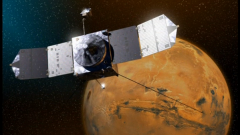
Reuters — A NASA science satellite circling Mars had to maneuver this week to avoid crashing into one of the planet’s two small moons, the U.S. space agency said on Thursday (March 2).
The MAVEN spacecraft, which is studying Mars’ vanishing atmosphere, fired up its engine on Tuesday to boost its speed by about 1.3 feet per second (0.4 meters per second) so it could steer clear of the Martian moon Phobos, the National Aeronautics and Space Administration said in a press release.
Without the tweak, MAVEN and the small, lumpy moon would have reached the same point in space within seven seconds of one another on Monday, March 6. In its new orbit, MAVEN will miss Phobos by about 2.5 minutes, NASA said.
MAVEN is in an egg-shaped orbit around Mars and regularly crosses the paths of other science satellites and of Phobos, which flies just 6,000 miles (3,700 km) above the planet’s surface, closer than any other known moon in the solar system. At that distance, Phobos whips around Mars three times a day.
Flight controllers at NASA’s Jet Propulsion Laboratory in Pasadena, Calif., regularly monitor MAVEN’s path for potential collisions.
Tuesday’s collision avoidance maneuver is the first MAVEN has made to steer clear of the potato-shaped Phobos, which measures about about 10 by 14 by 11 miles (17 by 22 by 18 km).








